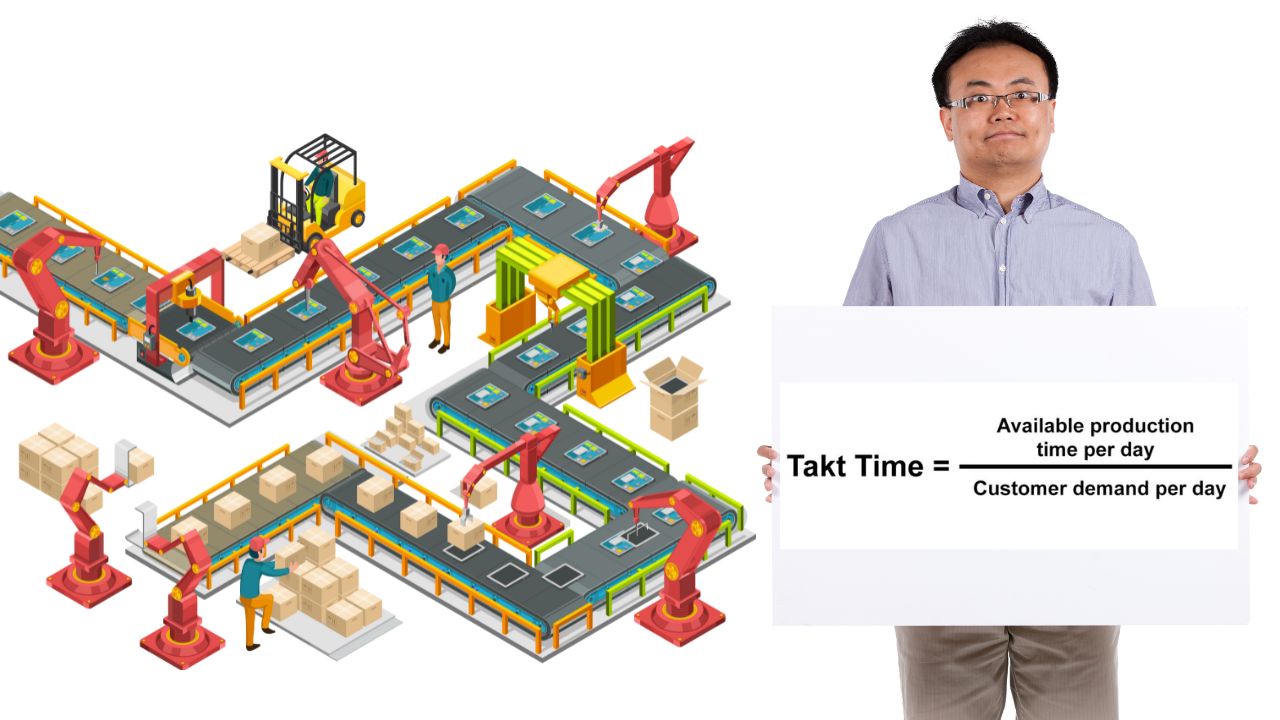Did you know that without understanding Takt time, you could be overproducing or underutilizing your resources? This time metric is considered the heartbeat of your production process and it can transform how you approach production.
Just as a heartbeat regulates the flow of blood through your body. Takt time regulates the flow of work on your shop floor. It sets the pace at which you need to produce each unit to meet customer demand, ensuring that you are neither overproducing nor underutilizing.
But how do you apply it to maximize efficiency that’s what I will explore here. In this article, I will discuss the fundamental concept of takt time, how to calculate it using one practical example, and its benefits as well as limitations.
So are you ready to synchronize your production with customer demand and take your efficiency to the next level? Then let’s get started…
What is Takt Time?
The term Takt originates from the German word for ‘Rhythm or Beat’ and it’s a concept that embodies the idea of timing and regularity much like the steady rhythm of a metronome. In the Lean context, Takt time is the heartbeat of your production process.
It basically ensures that every stage of the production process is in sync with the pulse of customer demand. It is the rate at which a finished product needs to be completed to meet customer demand.
The time metric acts as a powerful guiding principle in Lean manufacturing helping to synchronize production with market needs. By setting a clear pace for production, Takt time ensures that your process runs smoothly without overproduction or bottlenecks.
It aligns your production flow with customer demand and prevents waste as well as maximizes efficiency. In actual practice, Takt time serves as a benchmark for balancing workload across different stages of production.
If one process is lagging, it is a signal to investigate and address potential issues, such as inefficiencies, equipment breakdowns, or staffing challenges.
By maintaining the rhythm set by Takt time your organization can ensure that production is neither too fast nor too slow, but perfectly tuned to meet customer needs.
Why is Takt Time Important?
- Takt time keeps production in lockstep with customer needs, ensuring that you produce exactly what the customer wants and when they want it. That is customer-centric production.
- By adhering to this time metric, your organization can reduce waste associated with overproduction, excess inventory, and waiting times, all of which are key principles of Lean manufacturing.
- This time metric helps to streamline operations by ensuring that all parts of the production process are balanced and operating at optimal efficiency.
- It aids in the optimal use of resources, as it prevents the overburdening of any single part of the production process, leading to a more balanced workload across the production line.

How to calculate Takt Time?
Now you know the fundamental concept of this time metric. Let’s see how to calculate it step by step:
Takt time formula = Available production time / Customer demand
Available production time:
Total time available for production within a given period, typically a day or shift. This should exclude any planned downtime such as breaks, maintenance or shift changes.
For example, if you have an 8 hrs workday with 1 hrs of break and meetings, then your available production time would be 7 hrs.
Customer demand:
Next, find out how many units your customer needs within that same time period. This is your required output. For example, if your customer needs 140 units per day, this is your customer demand.
Once you know these 2 things you can calculate Takt time and apply that in your process to maximize efficiency. Let’s understand it using one practical example –
Practical example:
Imagine a XYZ factory producing bicycles. If the factory has 8 hrs of actual production time in the day (excluding break and meeting time) and the customer demand is 480 bicycles. Then Takt time would be:
8hrs means 8 × 60 minutes = 480 minutes
Takt time (TT) = 8 hrs / 480 bicycles = 480 minutes / 480 bicycles = 1 min per bicycle
This means that to meet the customer demand for 480 bicycles, the factory must produce one bicycle every minute. if they produce bicycles at a faster rate than the calculated takt time, they may overproduce and create unnecessary inventory.
If they produce bicycles at a lesser rate than the calculated TT, they may fail to meet customer demand and they need to increase resources to match the rate.
For both scenarios, you need to adjust the production process and try to match the production rate to the calculated TT value to meet customer demand on time. Regular monitoring is important in this case.
Benefits of TT:
- By aligning your production pace with demand, this time metric helps eliminate overproduction which is a key source of waste in lean manufacturing.
- This time metric provides a clear target for your team, making it easier to balance workloads, maintain smooth workflow, and identify bottlenecks.
- By consistently meeting customer demand on time, this time metric helps you build trust and satisfaction with your customers. This strengthens your reputation in the market.
- By setting up this time metric you can align your resources like manpower, machines, or materials perfectly with your production needs. This means less waste and more efficient use of what you have.
- When employees/workers understand the rhythm of production, they can perform their tasks more confidently and efficiently. This reduces stress, improves job satisfaction, and creates an effective work environment.
Limitations of TT:
- This time metric assumes that customer demand is constant, but in reality, demand can fluctuate. If you stick too rigidly to Takt time, you might find yourself overproducing during low-demand periods or struggling to keep up when demand spikes.
- Not all processes or task lengths are equal, some may take longer than others due to complexity, variability in material quality, or human factors. This time metric doesn’t account for these variations which can lead to bottlenecks if not managed properly.
- If takt time is set too aggressively, workers might feel pressured to work faster than is sustainable. This can lead to increased stress, higher rates of errors, and even burnout, which ultimately reduces overall efficiency.
- Focusing too much on Takt time can lead to a mindset where speed is prioritized over quality. This can result in defects, rework, and customer dissatisfaction, in the end destroying the purpose of Lean principles in the first place.
- In an organization where products need to be customized to specific customer requirements, sticking strictly to Takt time can be challenging. Customization often requires additional time, which can throw off the rhythm set by Takt time.
Comparison: Takt Time Vs Cycle Time Vs Lead Time
Now you know this one important time metric in lean, let’s compare this with other 2 time metrics cycle time and Lead time. These 3 time metrics are essential to manage during Lean implementation. Let’s compare them based on different parameters.
| Parameter | Takt time | Cycle time | Lead Time |
| Definition | The rate at which a product needs to be produced to meet customer demand. | The actual time taken to complete one cycle of the production process. | The total time from when an order is placed until the product is delivered. |
| Formula | Takt time = Available production time / Customer demand | The sum of all times from start to finish of a single production cycle. | Lead time = Procurement time + Production time + Delivery time |
| Purpose | To ensure production aligns with customer demand. | To measure how long it takes to produce one unit of product. | To track the total time a customer waits for their order. |
| Measurement focus | Production rate relative to demand. | Efficiency of the production process. | The overall time taken for an order to be completed. |
| Impact of improvement | Reduce production pace to match the customer demand, avoiding overproduction. | Decreases the time taken per unit, improving production efficiency. | Shortens the total time from order to delivery, improving customer satisfaction. |
| Example | If customer demand is 100 units per 8 hr shift, the Takt time is 4.8 minutes per unit. | If it takes 5 minutes to produce each unit, the cycle time is 5 minutes. | If an order is placed on January 1st and delivered on January 10th, the Lead time is 9 days. |
Now you understand everything about this important time metrics, but you know we discussed the theory part here, you will understand its real use in the production process when you learn this under the guidance of a Lean specialist.
For that I would recommend you to join EALSS Academy’s Lean Expert with 38 Lean Tools live training and 3 certification programs to learn the time metrics in Lean manufacturing with practical examples under the guidance of an expert.
Just click on the above link register for the program and join the official group of EALSS Academy. You can watch 1hrs FREE session recording inside to understand the instructor’s teaching style.
After joining the group, the support team will provide you with complete details about how to enroll in this program and get certified in 3 levels of Lean. ( Check out – All You Need to know about Lean Expert Live training program)
Conclusion
Understanding and implementing Takt time is like setting the heartbeat for your production process. When you get it right, everything flows smoothly resources are used efficiently, production meets customer demand, and waste is minimized.
But getting to that point requires more than just calculating the number, it is about team effort to create a continuous improvement culture where Takt time is the guiding principle for everyone. With this approach, your organization becomes most efficient.
By aligning your production pace with customer demand, Takt time helps you avoid the common pitfalls of overproduction and underutilization. It gives you the insight to balance workloads, streamline processes, and ensure that every product is delivered on time.
If you found this article useful then please share it in your network and subscribe to get more such articles every week.






very informative
great stuff